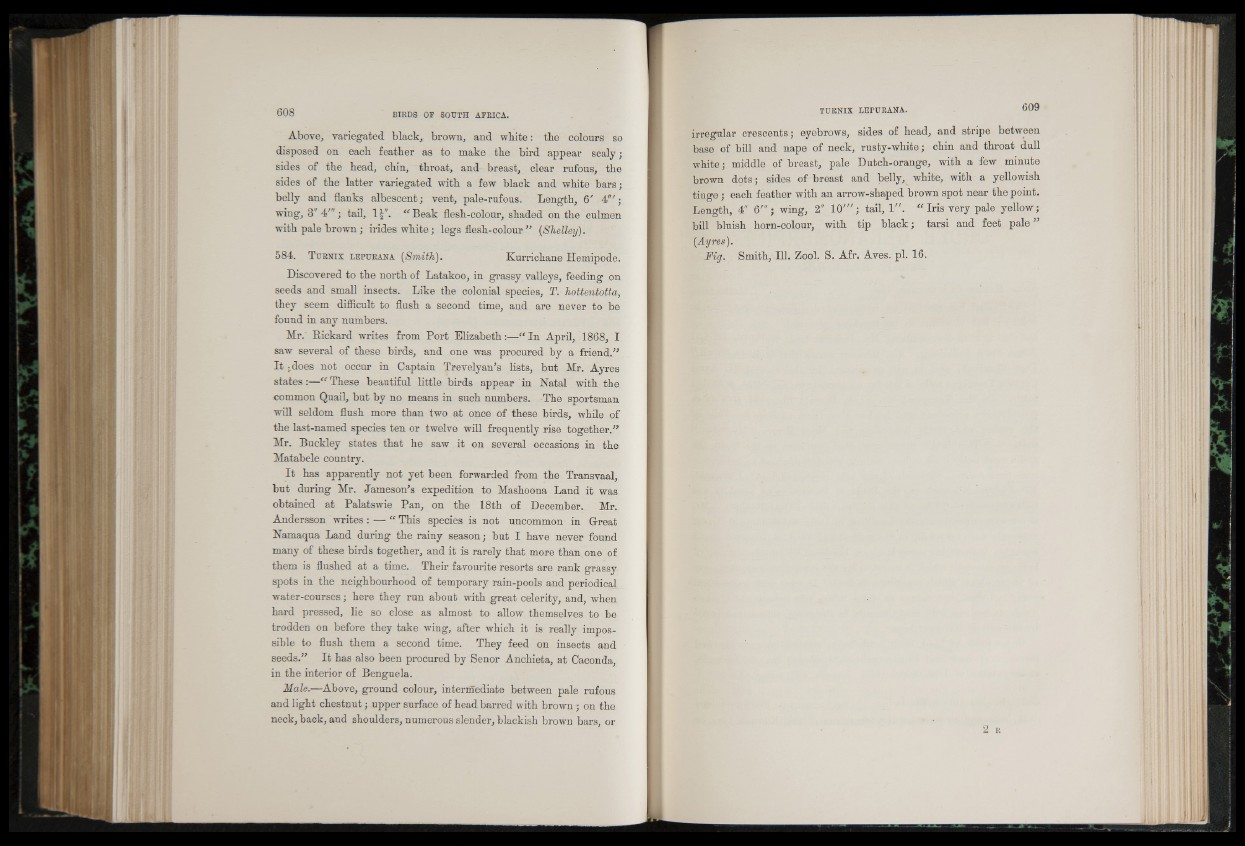
Above, variegated black, brown, and white: the colours so
disposed on each feather as to make the bird appear scaly ;
sides of the head, chin, throat, and breast, clear rufous, the
sides of the latter variegated with a few black and white bars;
belly and flanks albescent; vent, pale-rufous. Length, 6' 4'";
wing, 3" 4'"; tail, 11". “ Beak flesh-colour, shaded on the culmen
with pale brown; irides white; legs flesh-colour 55 (Shelley).
584. T u r n ix l e p u r a n a (Smith). Kurrichane Hemipode.
Discovered to the north of Latakoo, in grassy valleys, feeding on
seeds and small insects. Like the colonial species, T. hottentotta,
they seem difficult to flush a second time, and are never to be
found in any numbers.
Mr. Rickard writes from Port Elizabeth:—“ In April, 1868, I
saw several of these birds, and one was procured by a friend/ 5
I t .does not occur in Captain Trevelyan5s lists, but Mr. Ayres
states:—“ These beautiful little birds appear in Natal with the
common Quail, but by no means in such numbers. -The sportsman
will seldom flush more than two at once of these birds, while of
the last-named species ten or twelve will frequently rise together.55
Mr. Buckley states that he saw it on several occasions in the
Matabele country.
I t has apparently not yet been forwarded from the Transvaal,
but during Mr. Jameson5s expedition to Mashoona Land it was
obtained at Palatswie Pan, on the 18th of December. Mr.
Andersson writes: — f This species is not uncommon in Great
Namaqua Land during the rainy season; but I have never found
many of these birds together, and it is rarely that more than one of
them is flushed at a time. Their favourite resorts are rank grassy
spots in the neighbourhood of temporary rain-pools and periodical
water-courses; here they run about with great celerity, and, when
hard pressed, lie so close as almost to allow themselves to be
trodden on before they take wing, after which it is really impossible
to flush them a second time. They feed on insects and
seeds.55 It has also been procured by Senor Anchieta, at Caconda,
in the interior of Benguela.
Male.—Above, ground colour, intermediate between pale rufous
and light chestnut; upper surface of head barred with brown ; on the
neck, back, and shoulders, numerous slender, blackish brown bars, or
irregular crescents; eyebrows, sides of head, and stripe between
base of bill and nape of neck, rusty-white; chin and throat dull
white; middle of breast, pale Dutch-orange, with a few minute
brown dots; sides of breast and belly, ^ white, with a yellowish
tinge ; each feather with an arrow-shaped brown spot near the point.
Length, 4" 6"'; wing, 2" 10'"; tail, 1". " Iris very pale yellow;
bill bluish horn-colour, with tip black; tarsi and feet pale55
(Ayres).
Fig. Smith, -HI. Zool. S. Afr. Aves. pi. 16.